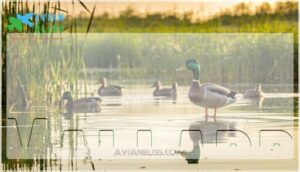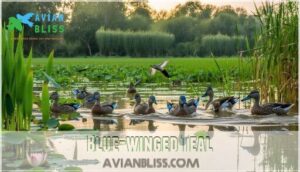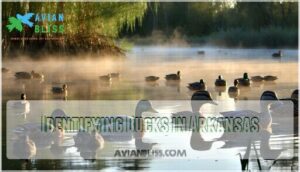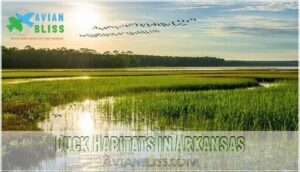This site is supported by our readers. We may earn a commission, at no cost to you, if you purchase through links.
 Every November, Arkansas becomes a top destination for waterfowl in North America. Over six million ducks pass through the Mississippi Flyway, with a huge number landing in the state’s flooded forests, rice fields, and wetlands. This isn’t just a number—it’s why hunters nationwide plan trips months ahead and why conservationists see Arkansas as key for waterfowl management.
Every November, Arkansas becomes a top destination for waterfowl in North America. Over six million ducks pass through the Mississippi Flyway, with a huge number landing in the state’s flooded forests, rice fields, and wetlands. This isn’t just a number—it’s why hunters nationwide plan trips months ahead and why conservationists see Arkansas as key for waterfowl management.
The green-headed mallards, colorful wood ducks, and flocks of teal that arrive each winter are a result of decades of habitat work and a long-standing hunting tradition. Whether you’re planning your first hunt or trying to spot ducks in your local marsh, understanding Arkansas’s duck scene involves knowing which species arrive, where they settle, and how conservation keeps their numbers strong.
From migration patterns to protective regulations, there’s more going on in those flooded areas than most realize.
Table Of Contents
- Key Takeaways
- Arkansas Duck Species
- Waterfowl Hunting in Arkansas
- Identifying Ducks in Arkansas
- Duck Habitats in Arkansas
- Arkansas Duck Migration Patterns
- Conservation of Ducks in Arkansas
- Duck Hunting Regulations in Arkansas
- Arkansas Duck Hunting Culture
- Arkansas Duck Conservation Efforts
- Frequently Asked Questions (FAQs)
- What is the most common duck in Arkansas?
- What happened to the ducks in Arkansas?
- What is the famous duck picture in Arkansas?
- Where did Kevin Costner duck hunt in Arkansas?
- What is the best time of year to see ducks in Arkansas?
- How do I attract ducks to my backyard in Arkansas?
- Can I raise ducks as pets in Arkansas?
- What are the most common duck predators in Arkansas?
- Are there any duck-watching tours available in Arkansas?
- What diseases affect wild ducks in Arkansas?
- Conclusion
Key Takeaways
- Arkansas hosts over six million ducks annually along the Mississippi Flyway, making it a critical stopover and wintering ground where flooded timber, rice fields, and wetlands support nearly half a million mallards and dozens of other species through strategic habitat management and conservation partnerships.
- Waterfowl hunting in Arkansas generates over $306 million in economic impact while funding wetland restoration through license fees and stamps, with strict bag limits and seasonal regulations ensuring sustainable harvest across 350,000+ acres of public hunting land.
- Conservation efforts have restored approximately 12,000 acres of wetlands in recent years through $3.5 million in investments from partnerships between Arkansas Game & Fish Commission, Ducks Unlimited, and private landowners, directly supporting population recovery and migration patterns.
- Peak duck viewing and hunting occurs November through February when cold fronts push massive flocks south, with identification made easier by recognizing dabbling ducks like mallards and teal that tip forward in shallow water versus diving species that disappear completely underwater.
Arkansas Duck Species
Arkansas sits right in the middle of the Mississippi Flyway, making it a hotspot for some of the country’s most diverse duck populations.
From the flashy mallards to the understated gadwall, you’ll spot everything from common backyard visitors to rare, hard-to-find species.
Here’s a look at five ducks you’re most likely to see when exploring Arkansas’s wetlands.
Mallard
If you’re cruising through Arkansas’ wetlands this fall, chances are the first duck to catch your eye will be a Mallard—that big, bold drake with the emerald-green head that practically glows in morning light. These ducks aren’t picky about where they set up shop. You’ll find them in flooded timber, rice fields, city ponds, and quiet backwaters across the state. Mallard Habitat ranges from wild to urban, making Duck Species Identification easy for beginners.
- Mallard Behavior includes showy courtship displays where drakes bob their heads and whistle to attract hens during breeding season
- Duck Feeding habits are diverse—they dabble for aquatic plants, snatch insects, and even scavenge grain from harvested fields
- As key players in Waterfowl Conservation, these migratory birds travel the Mississippi Flyway each year, making Arkansas a critical stopover during Duck Migration
Their adaptability keeps Waterfowl populations strong across the state.
Wood Duck
While Mallards hog the spotlight, the Wood Duck quietly steals the show with its kaleidoscope of colors—drakes sporting glossy green crests, chestnut breasts, and intricate white stripes that look like someone hand-painted each feather.
Look for them in Arkansas’s forested swamps and wooded wetlands, where they do something unusual for waterfowl—nest in tree cavities.
Those hollowed-out trunks aren’t just quirky real estate choices; wood ducks genuinely need them to breed, which is why protecting these habitats matters so much for populations along the Mississippi Flyway.
Gadwall
Don’t let the Gadwall’s muted palette fool you—this large dabbling duck packs more subtlety and stealth than any flashy drake you’ll find cruising Arkansas’s quiet lakes and marshes. Males sport intricate gray, brown, and black feather patterns that blend like camo, while their distinctive white wing patches flash during flight. Watch for their clever waterfowl behavior: they’re notorious food thieves, pilfering meals from diving ducks. Their medium-sized build and gray beak shapes make duck identification easier once you know what to spot.
Here’s what makes Gadwalls worth a closer look:
- Masters of disguise – Their understated plumage helps them thrive in gadwall habitat across Arkansas wetlands
- Opportunistic feeders – They’ll steal aquatic plants right from under diving ducks’ bills
- Migration champions – These duck species follow predictable routes along the Mississippi Flyway during duck migration
- Overlooked underdogs – While mallards grab headlines, Gadwalls quietly dominate many Arkansas waterfowl surveys
Northern Shoveler
If you’re looking for a duck that stands out, the Northern Shoveler has a massive spoon-shaped bill that makes it easy to identify in Arkansas’s shallow wetlands and flooded fields.
During breeding season, males show off vibrant green heads and white chests, while their unique beak shape helps them filter aquatic plants and invertebrates from muddy water.
These waterfowl follow migration routes through the Mississippi Flyway, arriving in Arkansas each fall. Their distinct feather patterns and feeding style set them apart from other duck species you’ll find in their statewide habitat.
Blue-winged Teal
Among Arkansas’s smallest dabbling ducks, the Blue-winged Teal packs a lot of personality into its compact frame, zipping through shallow wetlands with impressive agility. Males sport striking bluish-gray heads with white facial crescents, while their powder-blue wing patches flash during flight. Their feather identification makes spotting blue-winged teal among other duck species straightforward.
You’ll find these waterfowl in Arkansas’s flooded rice fields and marshes during migration:
- They arrive in early spring, following bird migration patterns through the Mississippi Flyway
- Small duck behavior includes quick takeoffs and tight flock formations
- Wetland conservation protects critical blue wing habitat for these energetic travelers
Waterfowl Hunting in Arkansas
Arkansas is a top destination for waterfowl hunting in the United States, attracting hunters from all over the country each season. Whether you prefer public land adventures or private guided trips, the state has options to suit your style.
Here’s what you need to know about duck hunting in Arkansas, including access, regulations, and the conservation efforts that keep this tradition thriving.
Prime Hunting Destination
Each winter, as ducks migrate down the Mississippi Flyway, Arkansas transforms into a hotspot for thrilling waterfowl hunting. The landscape is filled with flooded timber, rice fields, and marshes teeming with mallards and other species.
Careful harvest management keeps populations healthy, while the sound of duck calls fills the air over shifting water levels. Strategic blind placement and hunting techniques make Arkansas waterfowl hunting an unforgettable experience for conservation-minded hunters.
Public and Private Hunting Opportunities
Arkansas rolls out the welcome mat for duck hunters with over 350,000 acres of public Wildlife Management Areas—and that’s before you even count the lease lands, guided operations, and private clubs that dot the Delta like decoys on opening day.
Public lands offer budget-friendly access fees, while hunting leases and private reserves provide exclusive waterfowl hunting experiences.
Guided hunts connect you with local experts who know where ducks in Arkansas are stacking up, making waterfowl conservation in Arkansas work for everyone.
Regulations and Licenses
Getting your paperwork straight isn’t just red tape—it’s your ticket to freedom on Arkansas waters. License requirements kick in at 16, demanding both resident hunting permits and federal Waterfowl Stamps. You’ll need HIP registration too, plus hunter education if born after 1969.
To stay compliant, understanding hunter education requirements is key for all hunters.
- Break free from confusion with clear permit guidelines
- Access prime hunting spots through proper WMA permits
- Protect your hunting heritage with conservation stamps
- Join the ranks of licensed Arkansas waterfowl hunters
Conservation Efforts
Behind every duck landing in Arkansas wetlands is a network of conservationists most hunters never see.
Your hunting license dollars directly fund wetland restoration and habitat work on 12,000 acres each year.
Ducks Unlimited partners with AGFC on conservation strategies that maintain ecosystem balance, investing $3.5 million in wildlife preservation projects that keep waterfowl conservation thriving.
Identifying Ducks in Arkansas
Spotting ducks in Arkansas waters becomes second nature once you know what to look for. Different species have unique features that make identification straightforward, from beak shapes to flight patterns.
Let’s break down the main duck groups you’ll encounter and the key traits that’ll help you tell them apart in the field.
Dabbling Ducks
Picture a duck doing a headstand in shallow water—that’s your classic dabbler in action, and Arkansas wetlands are packed with these entertaining acrobats. These waterfowl species tip forward to grab aquatic vegetation and seeds.
You’ll spot Mallards with their iconic green heads, plus Gadwalls and Blue-winged Teals using these dabbling techniques throughout Arkansas marshes. To learn more about the different duck species and their habitats, visit information on duck species identification.
Diving/Sea Ducks
While dabblers put on their headstand show in the shallows, diving ducks take the plunge and disappear completely underwater to hunt for fish, mollusks, and aquatic invertebrates. These waterfowl use powerful leg strokes to reach impressive diving depths—some species can go 40 feet down! You’ll recognize diving duck species by their sleeker profiles and legs positioned farther back on their bodies.
You’ll find several diving duck species in Arkansas, each with telltale feather patterns:
- Ring-necked Ducks – steep black foreheads that’ll make you do a double-take
- Lesser Scaups – compact diving machines often mistaken for their greater cousins
- Canvasbacks – sloping red-eyed beauties with distinctive profiles
Their foraging habits and sea duck migration patterns make them fascinating water birds to observe.
Other Duck Species
Beyond the classic dabblers and divers, Arkansas waters host a colorful cast of other duck species that’ll keep you guessing and reaching for your binoculars.
You’ll encounter goldeneyes with their distinctive wing-whistling sound and buffleheads sporting bulbous heads with striking white patches. These diverse waterfowl showcase unique feather patterns and beak shapes that make duck species identification an exciting challenge.
Tips for Identification
Tell a bufflehead from a goldeneye? It gets easier fast once you know the markers. Your quick reference for duck species identification:
- Beak shapes – Shovelers sport spoon-like bills, while mergansers have serrated edges
- Head features – Look for crests, color patterns, and distinctive eye markings
- Feather patterns – Wing patches and body coloration tell the real story
- Duck calls – Each species has unique vocalizations worth memorizing
- Tail identifiers – Pintails show off pointed tails, while mallards display curled feathers
Practice makes perfect in waterfowl species recognition!
Duck Habitats in Arkansas
Arkansas ducks depend on a mix of habitats that shift with the seasons and water levels. From flooded hardwoods to working rice fields, these landscapes fuel the Mississippi Flyway’s migration.
Here’s where you’ll find ducks across the Natural State.
Wetlands
If you’ve ever watched a mallard tip tail-up to grab a snack just below the surface, you’ve seen wetlands at their best—feeding ducks. These vibrant systems are the backbone of waterfowl habitat in Arkansas, supporting everything from ecosystem services to habitat conservation efforts.
These wetlands pack everything ducks need to thrive:
- Shallow water zones where dabbling ducks forage without diving
- Submerged vegetation that filters water quality and provides cover
- Native plant communities supporting wetland ecology and conservation strategies
- Protected areas within wildlife refuges advancing wetlands conservation and habitat restoration
Arkansas’s commitment to waterfowl conservation ensures these landscapes stay productive year after year.
Flooded Timber
Wade into the chilly water under a canopy of oaks and cypress, and you’ll see why flooded timber is a duck’s paradise in Arkansas. This unique mix of forest and managed water levels creates the perfect spot for wood ducks and mallards to feast on acorns and invertebrates.
Timber management here isn’t about clearing everything—it’s about selective practices that keep mature trees while letting sunlight reach the forest floor. Arkansas waterfowl rely on these seasonally flooded hardwood bottoms, especially when restoration efforts keep water levels just right.
Conservation groups team up with landowners to protect these vital habitats, making sure ducks have the cover, food, and nesting spots they need to thrive year after year.
Rice Fields
When winter floods roll across Arkansas’ sprawling rice country, thousands of acres transform into a waterfowl magnet that rivals any natural wetland. Mallards and gadwalls pile into these flooded fields, feeding on leftover grain and aquatic invertebrates. Smart rice field management paired with wetland restoration keeps ducks in Arkansas thriving. Here’s how you can help healthy duck habitats and behaviors:
- Practice crop rotation to maintain soil health and food sources
- Use water conservation techniques during flooding cycles
- Coordinate flood control with migration timing
- Partner with wildlife conservation groups for habitat improvement
This agricultural landscape fuels Arkansas’ waterfowl tradition while boosting local farming communities.
Lakes and Marshes
Arkansas’ natural lakes and sprawling marshes provide year-round shelter where diving ducks and dabblers mingle, offering some of the most exciting waterfowl watching along the Mississippi Flyway. You’ll see canvasbacks, lesser scaups, and buffleheads sharing the water with mallards and blue-winged teals.
Healthy aquatic plants and careful lake management keep these wetlands thriving. Arkansas waterfowl flourish when marsh ecosystems remain balanced—water quality directly affects duck habitats and behaviors, making wetland restoration vital for future flocks.
Arkansas Duck Migration Patterns
Understanding duck migration patterns helps you know when to expect different species in Arkansas and why populations shift throughout the year. Ducks follow predictable routes and timing based on weather, breeding cycles, and food availability.
Here’s how migration works across the seasons and flyways that bring waterfowl to the state.
Spring Migration
Each spring brings a wave of ducks back through Arkansas, reversing the journey they made months earlier as they head north to nest and raise their young.
You’ll spot dabbling ducks like mallards and wood ducks leading the charge in February and March, pushing through the Mississippi Flyway as temperatures climb.
Peak spring migration hits in April when weather patterns stabilize and habitat changes trigger their instinct to move north toward breeding grounds.
Fall Migration
Cold fronts sweeping down from the north act like a starter pistol, sending massive flocks of ducks racing toward Arkansas’s legendary wetlands each fall. Blue-winged teal arrive first in late August, followed by waves of mallards and pintails as temperatures drop.
Peak migration hits mid-November when Siberian Express weather systems push birds down the Mississippi Flyway in impressive numbers, transforming flooded rice fields into duck magnets.
Wintering Grounds
Once those migrating flocks touch down in Arkansas, they’re here for the long haul—transforming the state’s flooded fields and bottomland forests into one of North America’s most important duck wintering areas. From December through February, you’ll find mallards, gadwalls, and pintails riding out the cold in Arkansas’s prime winter habitat.
These wintering grounds work because of a few key factors:
- Flooded rice fields provide easy foraging and energy-rich waste grain
- Greentree reservoirs offer protected roosting sites in flooded timber
- Strategic wetland management keeps food accessible throughout winter
- Conservation strategies maintain key waterfowl habitats across the Mississippi Flyway
Understanding these migratory patterns and duck behavior helps you appreciate Arkansas’s key role in waterfowl populations.
Flyways
The Mississippi Flyway channels roughly 40% of North America’s waterfowl straight through Arkansas each year—a bird highway connecting breeding grounds in Prairie Canada to Gulf Coast wintering areas. This flyway management system guides over 29 million ducks annually, with the Arkansas Delta and northeastern river systems serving as major congregation zones during peak migration patterns.
| Flyway Feature | Arkansas Role | Conservation Impact |
|---|---|---|
| Migration corridor | Central stopover and wintering hub | Protects 6.6 million migrating mallards |
| Habitat restoration | 12,000 acres restored in 2024 | Maintains waterfowl habitats and behaviors |
| Bird conservation | Adaptive management zones | Maintains Arkansas waterfowl populations |
| Wildlife preservation | $3.5M landowner incentives | Strengthens duck migration patterns |
Understanding flyways helps you see how bird migration connects entire ecosystems—from Prairie Potholes to flooded Arkansas rice fields.
Conservation of Ducks in Arkansas
Protecting Arkansas’s duck populations requires serious, daily commitment from various groups working together. State agencies, conservation organizations, and everyday hunters all contribute to keeping these birds thriving.
Let’s explore who’s doing what to secure the long-term health of waterfowl in the Natural State.
Arkansas Game & Fish Commission
The Arkansas Game & Fish Commission stands as the backbone of waterfowl management in the state, coordinating everything from population surveys to habitat restoration projects that keep duck numbers healthy and hunting opportunities strong. You’ll find their fingerprints on game regulations, enforcement efforts, and conservation funding that directly impacts Arkansas waterfowl populations and duck migration patterns.
Through fish stocking, wildlife management initiatives, and partnerships with organizations like Ducks Unlimited, the AGFC ensures Arkansas wildlife conservation stays on track for future generations.
Habitat Management
You can’t just fence off some acreage and call it duck habitat. These birds need the real deal—flooded timber, seasonal water shifts, the plants they actually eat. That means boots-on-the-ground work all year long.
In Arkansas, habitat conservation involves:
- Wetland restoration projects that recreate flooded timber and marsh complexes
- Strategic water management mimicking seasonal flood patterns
- Native plant establishment for food and cover
- Controlling invasive species threatening ecosystem balance
These sustainable practices maintain habitat diversity while supporting wildlife conservation across the entire Mississippi Flyway.
Waterfowl Surveys and Reports
You’ll want to track population trends through aerial surveys and waterfowl counts—hard data that drives real conservation decisions.
Arkansas Game and Fish Commission runs annual surveys each December and January, covering the Delta, Arkansas River Valley, and southwestern zones. January 2025 counts tallied 452,017 mallards and 924,545 total ducks in the Delta alone.
These habitat assessments and migration pattern reports reveal where ducks concentrate and how populations shift year-over-year, giving you the science behind effective waterfowl management.
Education and Outreach
Conservation gets real when duck lovers dive into the science behind what they’re watching. That shift from curious bystander to hands-on steward? It happens through good education and outreach.
Arkansas has plenty of ways to build your ornithology skills and strengthen your connection to the environment:
- Duck workshops and conservation courses teach wildlife identification and bird watching fundamentals.
- Outdoor programs connect you with ornithology research and habitat monitoring efforts.
- Wildlife education seminars break down migration patterns and survey data you can actually use.
- Volunteer opportunities put you in flooded timber and wetlands doing real bird identification work.
Duck Hunting Regulations in Arkansas
Before you head out to the marshes and flooded timber, you need to know the rules that keep Arkansas duck hunting sustainable and legal. The regulations cover when you can hunt, how many birds you can take, and what paperwork you need in your pocket.
Here’s what you need to stay on the right side of the law while chasing mallards and teal across the Natural State.
Season Dates
If you’re planning those early mornings in the blind, knowing when you can legally hunt makes all the difference. Arkansas duck hunting schedules change based on migration timing and conservation efforts.
Waterfowl hunters can enjoy early teal season in September, while the regular duck season usually runs from mid-November through late January. Peak seasons align with waterfowl calendars when migration brings birds south.
Check the Arkansas Game & Fish Commission’s website for exact dates—zones and species matter.
Bag Limits
Knowing your limits goes beyond restraint—it’s about respecting the resource that keeps you coming back season after season.
Arkansas sets a six-duck daily quota, with specific limits for each species: four mallards (only two hens), three wood ducks, two pintails, and one canvasback. These restrictions help manage wildlife and conserve duck populations along the Mississippi Flyway.
Following bag limits ensures Arkansas’s waterfowl hunting tradition continues for everyone.
Licenses and Permits
Before you drop a decoy or shoulder your shotgun, getting the right paperwork is your legal ticket to the marsh.
Arkansas waterfowl hunters need a state hunting license, federal duck stamp, and state waterfowl stamp. License requirements vary by age and residency, with different fee structures for residents versus out-of-state hunters.
The application process runs through the Arkansas Game & Fish Commission, whose permit types fund habitat restoration and conservation efforts statewide.
Arkansas Duck Hunting Culture
Duck hunting in Arkansas isn’t just a sport—it’s a way of life that runs deep through communities across the state. From century-old traditions passed down through generations to the serious dollars flowing through local economies, this culture shapes everything from weekend plans to conservation priorities.
Let’s look at what makes Arkansas duck hunting more than just pulling a trigger.
History of Duck Hunting
Duck hunting in Arkansas wasn’t born from catalogs or outfitters—it started at the dinner table. Early settlers needed waterfowl to survive, and those hand-carved decoys and pit blinds from the 1800s launched traditions that still live in today’s flooded timber.
Then the Migratory Bird Treaty Act hit in the early 1900s and flipped the script entirely:
- Market hunting ended, protecting Ducks in Arkansas from overharvest
- Vintage Gear evolved from basic shotguns to specialized waders
- Hunting Techniques shifted from commercial to sport-focused methods
- Conservation History began with habitat protection efforts
- Arkansas Waterfowl Hunting Heritage became woven into local identity
- Duck harvest numbers became regulated, keeping waterfowl hunters’ access sustainable
Organizations championed habitat conservation, protecting the wetlands that define this state’s hunting soul.
Cultural Significance
Around Stuttgart and across the Delta, duck hunting is more than a sport—it’s the thread that ties together generations, local economies, and a fiercely proud identity defining what it means to call Arkansas home. This Arkansas Waterfowl Hunting Heritage lives on in folklore stories shared at deer camps, duck art displayed in downtown galleries, and hunting traditions unchanged since your grandparents’ time.
Community events like Stuttgart’s Waterfowl Art Festival draw thousands into nature tourism, celebrating both the conservation efforts protecting ducks in Arkansas and the wildlife tourism revenue that keeps small towns thriving.
Here, respect for the land meets reverence for the birds—a culture built on patience, skill, and shared sunrise vigils in flooded timber.
Community Involvement
You don’t have to sit on the sidelines watching others disappear into the marsh at dawn—Arkansas’s duck hunting community welcomes newcomers and veterans alike through hands-on conservation work, local events, and a shared commitment to protecting what makes this place special.
Volunteer programs with groups like Ducks Unlimited let you restore wetlands alongside experienced hunters who’ll teach you the ropes. Join DU, attend local conservation partnerships meetings, or dive into public education workshops where nature tourism meets community outreach.
These aren’t just networking opportunities—they’re your gateway into a culture that thrives on shared stewardship.
Economic Impact
Beyond camaraderie and muddy boots, Arkansas’s duck hunting scene drives serious Local Spending—over $306 million during the 2022–2023 season alone. That translates to Hunting Jobs, retail surges, and packed hotels from Stuttgart to the Delta.
Duck Revenue fuels Conservation Funding through licenses and stamps, feeding habitat work and the Arkansas Game & Fish Commission’s Conservation mission.
When you buy that nonresident permit or join DU Membership, you’re backing wetland restoration and helping Ducks in Arkansas thrive for decades—a Tourism Boost with staying power.
Mobile Apps
Your phone’s already packed with gear checklists and weather updates—might as well throw in a few apps that actually help you find and outsmart those birds:
- Bird Identification tools like Merlin pinpoint Mallards from Wood Ducks instantly
- Duck Tracking apps flag migration pulses hitting Arkansas
- Hunting Logs record your hauls and favorite Dabbling Ducks spots
- Mobile Guides link you straight to the Conservation mission and Wildlife Cameras data
These aren’t gimmicks—they’re field-tested shortcuts that keep you sharper on Ducks in Arkansas.
Expert Advice
Sure, apps let you track flights and log your harvests—but the real insight? That comes from seasoned guides and biologists who’ve spent years reading weather fronts, watching how birds move, and nailing setup timing.
They’ll show you which Conservation Methods keep your go-to spots healthy and when Mallards or Wood Ducks reach their peak. Here’s what their field experience offers:
- Scout Habitat Tips for flooded timber and rice fields
- Master Waterfowl Strategies that match Dabbling Ducks patterns
- Back Conservation work that keeps Ducks in Arkansas thriving
Arkansas Duck Conservation Efforts
Arkansas isn’t just a magnet for hunters—it’s actively working to ensure duck populations thrive for future generations. Conservation efforts here involve hands-on work, field research, and community collaboration.
Let’s explore the real-world actions being taken across the state to protect these birds and their habitats.
Habitat Restoration
Arkansas wetlands don’t restore themselves—they need strategic intervention, funding, and partnerships between agencies like AGFC, Ducks Unlimited, and private landowners to rebuild the flooded forests and grasslands that ducks depend on.
Last season alone, these partners restored roughly 12,000 acres of wetlands with $3.5 million in habitat preservation investments.
You can join the effort through Ducks Unlimited membership and volunteerism, supporting conservation work that protects ecosystem balance from the Prairie Pothole Region all the way down to Arkansas’ flooded timber and rice fields.
Environmental sustainability starts with wetland conservation, and every acre matters for the ducks migrating through the Mississippi Flyway.
Waterfowl Management
Effective waterfowl management depends on three key priorities: population monitoring, habitat quality, and adaptive water control. The Arkansas Game & Fish Commission conducts annual surveys to track duck populations across the Delta and River Valley, adjusting conservation strategies based on real-time data.
Here’s where those efforts play out on the ground:
- Wetland restoration projects that rebuild flooded timber essential for dabbling ducks
- Water level manipulation in wildlife refuges to boost habitat quality
- Habitat preservation partnerships balancing agricultural needs with ecosystem health
- Targeted management for both diving ducks and surface-feeding species
These efforts protect the wetlands that keep Arkansas central to the Mississippi Flyway.
Research and Monitoring
Behind every duck count lies careful science. The Arkansas Game & Fish Commission conducts Aerial Surveys at 500 feet across the Delta and River Valley, tracking Population Dynamics through three major winter counts. Biologists band hundreds of wood ducks and geese each year for Waterfowl Tracking, monitoring Migration routes from breeding grounds through the Mississippi Flyway. Habitat Monitoring and Species Analysis distinguish Dabbling Ducks from Diving Ducks, with zone-by-zone data shaping adaptive management strategies that keep Arkansas wild.
| Research Method | Conservation Impact |
|---|---|
| Aerial transect surveys | Maps real-time duck distribution hotspots |
| Wood duck banding (460+ annually) | Tracks survival and harvest rates |
| Zone population modeling | Adjusts habitat restoration priorities |
| Band return analysis | Reveals migration corridors and timing |
| Longitudinal trend studies | Informs sustainable hunting regulations |
Community Engagement
Conservation doesn’t happen in isolation—it takes hunters, landowners, birders, and neighbors working together to keep Arkansas wetlands thriving. You can get involved through DU Events like banquets and habitat workdays, where you’ll meet Major Sponsors and fellow conservationists.
Volunteering connects you directly to restoration projects, while Public Events and Social Media help spread awareness.
Local Partnerships with community groups boost impact—whether you Volunteer, Sponsor Members, or lead Community Outreach, every contribution counts in protecting the flyway.
Frequently Asked Questions (FAQs)
What is the most common duck in Arkansas?
Mallards dominate Arkansas wetlands year-round. These striking ducks—males sporting emerald heads and bright yellow bills—make up nearly half the state’s total duck population.
In January 2025, surveys counted over 452,000 mallards across the Arkansas Delta alone, confirming their status as the region’s most abundant waterfowl species.
What happened to the ducks in Arkansas?
Duck population trends show fluctuations, not disappearances. Recent surveys found over 900,000 ducks in the Arkansas Delta, though numbers run below historical averages.
Habitat loss and shifting migration patterns affect when and where birds arrive, but wetlands still draw massive flocks each winter.
What is the famous duck picture in Arkansas?
The Claypool picture stands as one of waterfowl photography’s most celebrated images. George Purvis captured roughly 300,000 mallards lifting off Claypool Reservoir in 1956, creating an unforgettable snapshot of Arkansas duck migration and hunting heritage.
Where did Kevin Costner duck hunt in Arkansas?
Hollywood legends sometimes chase wild rumors, but Kevin Costner’s Arkansas duck hunting trip remains unconfirmed. No credible sources document him hunting Arkansas Wetlands—unlike the Mallards and Wood Ducks that reliably migrate through Film Locations statewide.
These Celebrity Outings in Arkansas often spark folklore among Diving Ducks enthusiasts, blending fact with fiction.
What is the best time of year to see ducks in Arkansas?
Peak Viewing Times arrive during late fall and winter—November through February—when massive waterfowl flocks follow the Mississippi Flyway south.
Migration pushes duck species into Arkansas’s seasonal habitat, especially during cold fronts when dabbling ducks concentrate in flooded rice fields and wetlands.
How do I attract ducks to my backyard in Arkansas?
Telegram your local waterfowl by installing a backyard pond stocked with native grasses and aquatic plants.
Add duck-friendly plants around shallow water features, scatter cracked corn near wetlands-style edges, and let dabbling ducks discover your Arkansas oasis naturally.
Can I raise ducks as pets in Arkansas?
Raising ducks as pets is legal in Arkansas, but local zoning laws vary by city and county.
You’ll need proper Backyard Fencing, fresh water access, and shelter. Check regulations first, then connect with Local Breeders for healthy birds and Duck Care Tips on nutrition and preventing Duck Health Issues.
What are the most common duck predators in Arkansas?
Predators shape wetlands like invisible hands sculpting clay. In Arkansas ecosystems, foxes, raccoons, coyotes, hawks, and owls hunt ducks regularly. Snapping turtles and snakes target young birds in shallow waters.
Wildlife management and predator control efforts help maintain ecosystem balance while supporting healthy duck species populations throughout migration seasons.
Are there any duck-watching tours available in Arkansas?
Guided birdwatching expeditions bring you face-to-face with waterfowl across Arkansas wetlands.
You’ll explore prime migration habitats with wildlife guides who know exactly where ducks gather—from flooded timber to marshes teeming with Mallards and Wood Ducks during peak season.
What diseases affect wild ducks in Arkansas?
Wild ducks face serious health threats—what should you watch for? Avian Influenza poses the biggest risk during migration through Arkansas wetlands.
Mallards and other duck species also contract Fowl Cholera, bacterial infections, waterborne illness, and duck parasites that spread rapidly in crowded habitats.
Conclusion
Arkansas duck hunting tells the story better than any statistic could. When habitat gets protected, rules stay sensible, and locals stay involved, wetlands don’t just survive—they flourish.
When habitat gets protected, rules stay sensible, and locals stay involved, wetlands flourish and waterfowl traditions thrive for future generations
Whether you’re tracking mallards through flooded timber or watching teal splash down in rice fields, you’re seeing decades of effort pay off. Get licensed, learn the species, respect the limits, and you’ll connect with one of North America’s richest waterfowl traditions while helping protect it for future generations.
- https://www.agfc.com/news/arkansas-wildlife-weekly-waterfowl-report-33/
- https://armoneyandpolitics.com/arkansas-hunting-conservation/
- https://katv.com/news/local/over-100000-hunters-expected-for-arkansas-2023-2024-duck-hunting-season-despite-dry-conditions-wildlife-magazine-arkansas-game-fish-harvested-season-blinds-deer-migration-pattern-cold-dna-central-mississippi-flyways
- https://thelensnola.org/2025/04/14/delta-duck-hunting-offers-conservation-solutions-but-the-ducks-are-disappearing/
- https://adpht.arkansas.gov/office-of-outdoor-recreation/economic-impact/
















